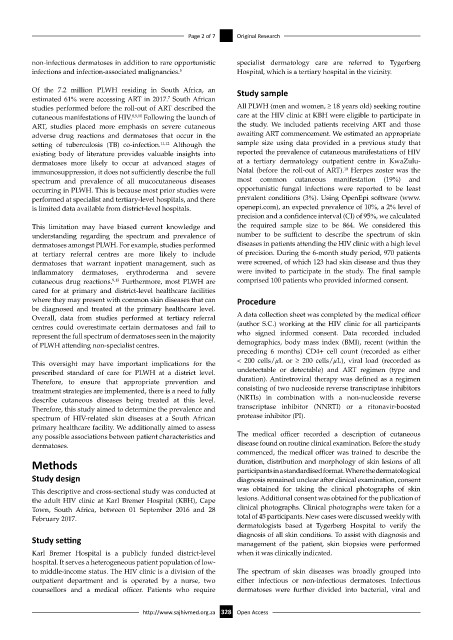Page 336 - HIVMED_v21_i1.indb
P. 336
Page 2 of 7 Original Research
non-infectious dermatoses in addition to rare opportunistic specialist dermatology care are referred to Tygerberg
infections and infection-associated malignancies. 5 Hospital, which is a tertiary hospital in the vicinity.
Of the 7.2 million PLWH residing in South Africa, an Study sample
7
estimated 61% were accessing ART in 2017. South African
studies performed before the roll-out of ART described the All PLWH (men and women, ≥ 18 years old) seeking routine
cutaneous manifestations of HIV. 8,9,10 Following the launch of care at the HIV clinic at KBH were eligible to participate in
ART, studies placed more emphasis on severe cutaneous the study. We included patients receiving ART and those
adverse drug reactions and dermatoses that occur in the awaiting ART commencement. We estimated an appropriate
setting of tuberculosis (TB) co-infection. 11,12 Although the sample size using data provided in a previous study that
existing body of literature provides valuable insights into reported the prevalence of cutaneous manifestations of HIV
dermatoses more likely to occur at advanced stages of at a tertiary dermatology outpatient centre in KwaZulu-
10
immunosuppression, it does not sufficiently describe the full Natal (before the roll-out of ART). Herpes zoster was the
spectrum and prevalence of all mucocutaneous diseases most common cutaneous manifestation (19%) and
occurring in PLWH. This is because most prior studies were opportunistic fungal infections were reported to be least
performed at specialist and tertiary-level hospitals, and there prevalent conditions (3%). Using OpenEpi software (www.
is limited data available from district-level hospitals. openepi.com), an expected prevalence of 10%, a 2% level of
precision and a confidence interval (CI) of 95%, we calculated
This limitation may have biased current knowledge and the required sample size to be 864. We considered this
understanding regarding the spectrum and prevalence of number to be sufficient to describe the spectrum of skin
dermatoses amongst PLWH. For example, studies performed diseases in patients attending the HIV clinic with a high level
at tertiary referral centres are more likely to include of precision. During the 6-month study period, 970 patients
dermatoses that warrant inpatient management, such as were screened, of which 123 had skin disease and thus they
inflammatory dermatoses, erythroderma and severe were invited to participate in the study. The final sample
cutaneous drug reactions. 9,13 Furthermore, most PLWH are comprised 100 patients who provided informed consent.
cared for at primary and district-level healthcare facilities
where they may present with common skin diseases that can Procedure
be diagnosed and treated at the primary healthcare level.
Overall, data from studies performed at tertiary referral A data collection sheet was completed by the medical officer
centres could overestimate certain dermatoses and fail to (author S.C.) working at the HIV clinic for all participants
represent the full spectrum of dermatoses seen in the majority who signed informed consent. Data recorded included
of PLWH attending non-specialist centres. demographics, body mass index (BMI), recent (within the
preceding 6 months) CD4+ cell count (recorded as either
This oversight may have important implications for the < 200 cells/µL or ≥ 200 cells/µL), viral load (recorded as
prescribed standard of care for PLWH at a district level. undetectable or detectable) and ART regimen (type and
Therefore, to ensure that appropriate prevention and duration). Antiretroviral therapy was defined as a regimen
treatment strategies are implemented, there is a need to fully consisting of two nucleoside reverse transcriptase inhibitors
describe cutaneous diseases being treated at this level. (NRTIs) in combination with a non-nucleoside reverse
Therefore, this study aimed to determine the prevalence and transcriptase inhibitor (NNRTI) or a ritonavir-boosted
spectrum of HIV-related skin diseases at a South African protease inhibitor (PI).
primary healthcare facility. We additionally aimed to assess
any possible associations between patient characteristics and The medical officer recorded a description of cutaneous
dermatoses. disease found on routine clinical examination. Before the study
commenced, the medical officer was trained to describe the
Methods duration, distribution and morphology of skin lesions of all
participants in a standardised format. Where the dermatological
Study design diagnosis remained unclear after clinical examination, consent
This descriptive and cross-sectional study was conducted at was obtained for taking the clinical photographs of skin
the adult HIV clinic at Karl Bremer Hospital (KBH), Cape lesions. Additional consent was obtained for the publication of
Town, South Africa, between 01 September 2016 and 28 clinical photographs. Clinical photographs were taken for a
February 2017. total of 45 participants. New cases were discussed weekly with
dermatologists based at Tygerberg Hospital to verify the
Study setting diagnosis of all skin conditions. To assist with diagnosis and
management of the patient, skin biopsies were performed
Karl Bremer Hospital is a publicly funded district-level when it was clinically indicated.
hospital. It serves a heterogeneous patient population of low-
to middle-income status. The HIV clinic is a division of the The spectrum of skin diseases was broadly grouped into
outpatient department and is operated by a nurse, two either infectious or non-infectious dermatoses. Infectious
counsellors and a medical officer. Patients who require dermatoses were further divided into bacterial, viral and
http://www.sajhivmed.org.za 328 Open Access

